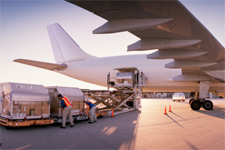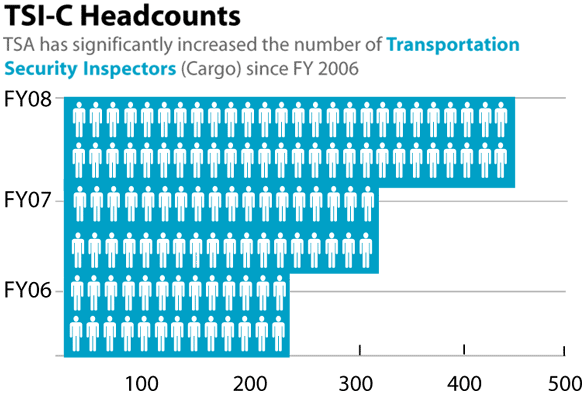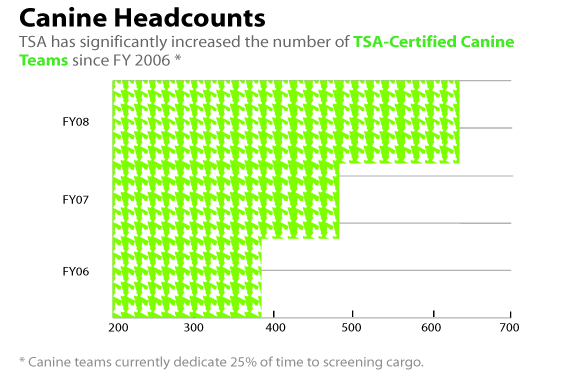Air Cargo
Layers of Security
Certified Cargo Screening Program | Air Cargo Regulations | Shippers and Inquiries
 When most people use shipping companies, they assume that their next day or two-day package is rushed to the airport immediately to hop onto the next flight. Only a small percent of packages actually make it onto an airplane. An even smaller amount is placed on a passenger-carrying plane. Of the hundreds of thousands of tons of cargo shipped from coast to coast every day, only about 50,000 tons are classified as air cargo. Of that amount, about one quarter is shipped by domestic passenger air carriers.
When most people use shipping companies, they assume that their next day or two-day package is rushed to the airport immediately to hop onto the next flight. Only a small percent of packages actually make it onto an airplane. An even smaller amount is placed on a passenger-carrying plane. Of the hundreds of thousands of tons of cargo shipped from coast to coast every day, only about 50,000 tons are classified as air cargo. Of that amount, about one quarter is shipped by domestic passenger air carriers.
The Transportation Security Administration (TSA) is responsible for ensuring the security of all modes of transportation, including cargo placed aboard airplanes and particularly focuses on passenger-carrying planes.
TSA worked closely with Congress for more than six months to significantly strengthen security in air cargo through the 9/11 Bill, which was signed into law on August 3, 2007. TSA has met the mandates of the law to date and currently 50 percent of air cargo on passenger carrying aircraft is screened. One hundred percent of the cargo on 96 percent of the flights originating in the United States is now screened. Eighty-five percent of the passengers flying each day from U.S. airports are on planes where all of the cargo has been fully screened.
One step in achieving 100 percent screening is the requirement for all airlines operating narrow body passenger aircraft from U.S. airports to screen 100 percent of cargo transported on them.
By working with air carriers and members of the air cargo community, we began screening 100 percent of cargo transported on narrow-body (single-aisle) aircraft. TSA achieved this milestone in October 2008 — a full 22 months before the deadline.
The passenger security impact of this screening is significant: although these aircraft carry only 25 percent of domestic air cargo on passenger aircraft, they account for the majority - approximately 95 percent - of domestic passenger flights. More importantly, these flights carry more than 80 percent of all passengers on flights originating in the United States. Even at the statutory deadline for screening 50 percent of air cargo aboard passenger aircraft, TSA is effectively protecting the vast majority of the flying public.
TSA already has in place a multi-layered, high-tech, industry-cooperative approach, utilizing surprise cargo security inspections called "strikes," covert testing, security directives and 100 percent screening at 250 smaller airports. In 2008, TSA eliminated all exemptions to screening of air cargo for the first time and increased the amount of cargo which is subject to mandatory screening.
With TSA's new air cargo regulation, TSA will be doing 100,000 more background checks, specifically on cargo employees who screen cargo and/or have knowledge of how it is going to be transported or actually transport the cargo. The rule requires more robust checks and more visibility on the shipping companies and their employees. Additionally, we have extended security areas at the airport to include air cargo areas.
Transportation Security Inspectors (TSIs)

To ensure a high level of compliance with our regulations, TSA employs 420 Cargo Transportation Security Inspectors (TSIs), who are exclusively dedicated to the oversight of air cargo. By the end of this year, we expect to have all approximately 450 authorized inspector positions filled and trained. Additionally, each inspector will receive behavior observation training to spot anything suspicious while they're completing their regulatory duties.
Canine Teams

TSA's more than 460 canine teams each spend at least 25 percent of their work day in the cargo environment. TSA currently has 85 canine teams specifically assigned to the screening of air cargo at our nation’s highest cargo volume airports. This presence has significantly increased the amount of cargo screening we are able to conduct.


